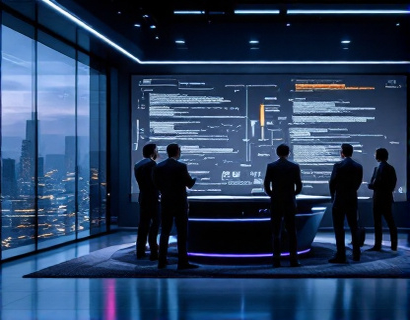Maximizing Business Collaboration and Efficiency with Advanced External Stakeholder Management Software Solutions
In today's fast-paced business environment, organizations of all sizes face the challenge of managing external stakeholders effectively. These stakeholders include users, partners, contractors, and other entities that play a crucial role in the success of a business. The ability to streamline interactions and enhance collaboration with these external parties is vital for maintaining efficiency and achieving strategic goals. Advanced external stakeholder management software solutions offer a powerful way to address these challenges, providing tools and features that optimize management and collaboration across the board.
Understanding the Importance of External Stakeholder Management
External stakeholders are integral to a business's operations, contributing to various aspects such as project execution, supply chain management, and market expansion. Effective management of these relationships ensures that all parties are aligned, communication is seamless, and objectives are met promptly. However, traditional methods of managing external stakeholders often lead to disorganization, miscommunication, and inefficiency. This is where advanced software solutions come into play, offering a comprehensive approach to streamline these processes.
Key Features of Advanced Stakeholder Management Software
Advanced stakeholder management software is designed to address the specific needs of businesses in managing external relationships. Some of the key features include:
- Centralized Database: A single platform to store and manage all stakeholder information, including contact details, project assignments, and communication history.
- Automated Workflows: Predefined processes that automate routine tasks such as sending reminders, updating statuses, and generating reports, reducing manual effort and errors.
- Real-Time Collaboration: Tools that enable stakeholders to collaborate in real-time, share documents, and discuss project details directly within the platform.
- Customizable Dashboards: User-friendly interfaces that provide a visual overview of stakeholder activities, project progress, and key metrics at a glance.
- Role-Based Access Control: Ensuring that stakeholders have access only to the information and features relevant to their role, enhancing security and compliance.
Centralized Database for Comprehensive Stakeholder Management
A centralized database is the backbone of any effective stakeholder management system. It allows businesses to consolidate all stakeholder data in one place, providing a complete and up-to-date view of each relationship. This includes contact information, communication history, project assignments, and performance metrics. By having all this information in one location, businesses can easily track stakeholder interactions, identify potential issues, and make informed decisions. For instance, a project manager can quickly access a contractor's past performance and communication style to better manage ongoing projects.
Automated Workflows for Increased Efficiency
Automated workflows are a game-changer in stakeholder management. By defining and automating routine tasks, businesses can significantly reduce manual effort and the risk of human error. For example, automated email notifications can remind stakeholders of upcoming deadlines, request feedback, or update them on project progress. Similarly, automated report generation can provide regular updates on stakeholder activities and project statuses, ensuring that everyone is informed without the need for manual reporting. This not only saves time but also ensures consistency and accuracy in communication.
Real-Time Collaboration for Enhanced Productivity
Real-time collaboration tools are essential for fostering effective communication and teamwork among external stakeholders. These tools enable stakeholders to work together seamlessly, regardless of their physical location. Features such as shared document editing, instant messaging, and video conferencing facilitate smooth collaboration and help overcome the challenges of remote work. For instance, a cross-functional team working on a global project can collaborate in real-time, share files instantly, and hold virtual meetings to discuss progress and address issues promptly. This level of collaboration not only speeds up project completion but also enhances the quality of outcomes.
Customizable Dashboards for Insightful Monitoring
Customizable dashboards provide a visual and intuitive way to monitor stakeholder activities and project progress. These dashboards can be tailored to display the most relevant metrics and information for each user, making it easier to track performance and identify areas for improvement. For example, a business owner can set up a dashboard that shows the status of all ongoing projects, the performance of external partners, and key financial metrics. This real-time visibility helps in making data-driven decisions and taking proactive measures to address any issues that arise.
Role-Based Access Control for Enhanced Security
Security is a critical concern when managing external stakeholders, especially when sensitive information is involved. Role-based access control ensures that stakeholders have access only to the information and features necessary for their role. This not only protects sensitive data but also ensures compliance with regulatory requirements. For instance, a supplier may need access to project details and payment terms but not to confidential business strategies. By implementing role-based access control, businesses can maintain a balance between accessibility and security, fostering trust among stakeholders.
Benefits of Implementing Advanced Stakeholder Management Software
The implementation of advanced stakeholder management software brings numerous benefits to businesses of all sizes. Some of the most significant advantages include:
Improved Communication and Collaboration
Advanced software solutions facilitate better communication and collaboration among stakeholders. By providing a centralized platform for interaction, businesses can reduce misunderstandings and ensure that all parties are on the same page. This leads to more efficient problem-solving and faster decision-making, ultimately driving project success.
Increased Efficiency and Productivity
Automated workflows and streamlined processes reduce the time and effort required to manage external stakeholders. This allows business teams to focus on core activities, increasing overall productivity and efficiency. For example, automating routine tasks such as sending reminders and generating reports frees up valuable time for more strategic tasks.
Enhanced Visibility and Control
With real-time dashboards and comprehensive reporting, businesses gain enhanced visibility into stakeholder activities and project progress. This level of control enables managers to monitor performance, identify bottlenecks, and take corrective actions promptly. As a result, projects are more likely to stay on track and meet their deadlines.
Better Risk Management
Advanced stakeholder management software helps in identifying and mitigating risks associated with external relationships. By tracking stakeholder performance and communication, businesses can proactively address potential issues before they escalate. This proactive approach to risk management contributes to the overall stability and success of the business.
Scalability for All Organizational Sizes
One of the most significant advantages of advanced stakeholder management software is its scalability. Whether you are a small startup or a large enterprise, these solutions can adapt to your specific needs and grow with your business. This flexibility ensures that businesses of all sizes can benefit from the same level of efficiency and collaboration, without the need for extensive customization or additional investments.
Case Studies and Success Stories
Several businesses have successfully implemented advanced stakeholder management software, achieving significant improvements in collaboration and efficiency. For example, a multinational construction company adopted a comprehensive stakeholder management platform to streamline interactions with suppliers, contractors, and clients. The result was a 30% reduction in project delays and a 25% increase in stakeholder satisfaction. Another instance is a tech startup that used real-time collaboration tools to enable seamless communication among its distributed team, leading to faster product development cycles and higher customer satisfaction.
Conclusion
In conclusion, advanced external stakeholder management software solutions offer a powerful way to enhance collaboration and efficiency in business operations. By centralizing stakeholder data, automating workflows, enabling real-time collaboration, providing customizable dashboards, and ensuring role-based access control, these solutions address the key challenges faced by businesses in managing external relationships. The benefits of improved communication, increased efficiency, enhanced visibility, better risk management, and scalability make a compelling case for adopting such software. As businesses continue to evolve and face new challenges, the strategic use of advanced stakeholder management tools will be crucial in maintaining a competitive edge and achieving long-term success.










































